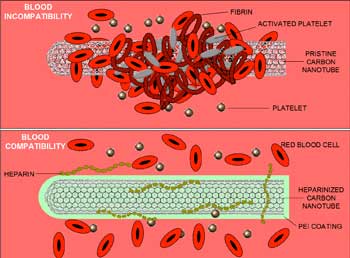| May 04, 2006 |
Blood-compatible nanoscale materials possible using heparin
|
|
(Nanowerk News) Researchers from Rensselaer Polytechnic Institute have engineered nanoscale materials that are blood compatible using heparin, an anticoagulant. The heparin biomaterials have potential for use as medical devices and in medical treatments such as kidney dialysis.
|
|
The researchers prepared several materials with heparin composites or coatings, including carbon nanotubes, nanofibers, and membranes with nanosized pores, and then demonstrated the materials’ high compatibility with blood. Heparin is a common therapeutic used to maintain blood flow or prevent clotting during medical procedures and treatments.
|
|
The researchers demonstrated the composite heparin membrane with nanopores could work as an artificial kidney, or dialyzer, by filtering the blood and maintaining its flow. The presence of this blood-compatible dialyzer could potentially eliminate the need for systemic administration of heparin to the patient during kidney dialysis, the researchers say.
|
|
The heparin-coated membranes are described in a paper titled "Ionic Liquid-Derived Blood Compatible Membranes for Kidney Dialysis," published online Apr. 24 in advance of print in the Journal of Biomedical Materials Research.
|
 |
(Source: Rensselaer/Robert Linhardt)
|
|
“These heparin composite membranes and fibers and coated carbon nanotubes are an enabling technology,” says Saravanababu Murugesan, a recent doctoral graduate in chemical and biological engineering at Rensselaer and lead author of the paper. “Our results show these novel materials have great promise in the development of improved medical devices that are blood compatible.”
|
|
The research team is led by Robert Linhardt, the Ann and John H. Broadbent Jr. ’59 Senior Constellation Professor of Biocatalysis and Metabolic Engineering at Rensselaer, and includes collaboration with Pulickel Ajayan, the Henry Burlage Professor of Materials Science and Engineering, and Omkaram “Om” Nalamasu, professor of materials science and engineering, at Rensselaer. Additional co-authors of the paper are Shaker Mousa, director of the Pharmaceutical Research Institute at Albany College of Pharmacy, and Aravind Vijayaraghavan, a recent doctoral graduate in materials science and engineering at Rensselaer. Funding for this research was provided by the National Institutes of Health.
|
|
Recent results related to this work have been published online in the journals Langmuir (“Blood Compatible Nanotubes – Nano-based Neoproteoglycans,” Mar. 11, 2006) and Biomacromolecules (“Preparation of Biopolymer Fibers by Electrospinning from Room Temperature Ionic Liquids,” Jan. 26, 2006). Provisional patents have been filed by Rensselaer Polytechnic Institute.
|
|
Research in Linhardt’s group at the Center for Biotechnology and Interdisciplinary Studies at Rensselaer focuses on complex carbohydrates such as heparin. After determining the structure of these molecules, researchers study their biological activities to establish a structure-activity relationship that may reveal lead compounds for new drug development. Recent discoveries include a synthetic method for preparation of heparin in quantities large enough for use in medical treatment.
|

